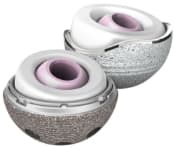What makes a mobile bearing hip so different?
To help alleviate your hip pain and get you moving again, we’ve developed the Mobile Bearing Hip System designed to help prevent dislocation.

Our Mobile Bearing Hip System features X3 Precisely Engineered Polyethylene that may enhance joint stability,1 provide a more natural range of motion,1 and minimize the risk of wear that may help prolong the life of the implant.2,3
References:
- Heffernan C, Bhimji S, Macintyre J, et al. (2011). Development and Validation of a Novel Modular Dual Mobility Hip Bearing. ORS Annual Meeting Poster #1165.
- Stryker Orthopaedics Restoration® ADM X3® 28 mm ID acetabular inserts made of X3® Gas Plasma Sterilized UHMWPE, show a 97% reduction in volumetric wear rate versus 28 mm ID Restoration® ADM Duration Gamma Radiation Sterilized UHMWPE. Both ADM constructs utilized a 54mm OD shell and the inserts were approximately 9.9 mm thick. Testing was conducted under multi-axial hip joint simulation for 5 million cycles using a 28mm CoCr modular femoral head articulating counterface and calf serum lubricant. Volumetric wear rates were 109.7±6.0 mm3/106 cycles and -1.03 ± 3.8 mm3/106 cycles for Duration and X3® polyethylene insert test samples. Although in-vitro hip wear simulation methods have not been shown to quantitatively predict clinical wear performance, the current model has been able to reproduce correct wear resistance rankings for some materials with documented clinical results.A-C (A. Wang A, et al. Tribology International, Vol. 31, No. 1-3:17-33, 1998; B. Essner A, et al. 44th Annual Meeting, ORS, New Orleans, Mar. 16-19, 1998:774; C. Essner A, et al. 47th Annual Meeting, ORS, San Francisco, Feb. 25-28, 2001:1007.)
- Herrera L, Lee R, Longaray J, et al. (2010). Edge Loading Wear Due to Inclination Angle for Three Contemporary Hip Bearings. 56th Annual ORS Meeting. Poster #2259.
U.S. Modular Hip Settlement Program
Stryker's Voluntary Recall of Rejuvenate and ABG II Modular-Neck Hip Stems
Hip Replacements
Hip joint replacement is intended for use in individuals with joint disease resulting from degenerative and rheumatoid arthritis, avascular necrosis, fracture of the neck of the femur or functional deformity of the hip.
Joint replacement surgery is not appropriate for patients with certain types of infections, any mental or neuromuscular disorder which would create an unacceptable risk of prosthesis instability, prosthesis fixation failure or complications in postoperative care, compromised bone stock, skeletal immaturity, severe instability of the joint, or excessive body weight.
Like any surgery, joint replacement surgery has serious risks which include, but are not limited to, pain, infection, bone fracture, change in the treated leg length (hip), joint stiffness, hip joint fusion, amputation, peripheral neuropathies (nerve damage), circulatory compromise (including deep vein thrombosis (blood clots in the legs)), genitourinary disorders (including kidney failure), gastrointestinal disorders (including paralytic ileus (loss of intestinal digestive movement)), vascular disorders (including thrombus (blood clots), blood loss, or changes in blood pressure or heart rhythm), bronchopulmonary disorders (including emboli, stroke or pneumonia), heart attack, and death.
Implant related risks which may lead to a revision of the implant include dislocation, loosening, fracture, nerve damage, heterotopic bone formation (abnormal bone growth in tissue), wear of the implant, metal and/or foreign body sensitivity, soft tissue imbalance, osteolysis (localized progressive bone loss), audible sounds during motion, and reaction to particle debris. Hip implants may not provide the same feel or performance characteristics experienced with a normal healthy joint.
The information presented is for educational purposes only. Speak to your doctor to decide if joint replacement surgery is appropriate for you. Individual results vary and not all patients will return to the same activity level. The lifetime of any joint replacement is limited and depends on several factors like patient weight and activity level. Your doctor will counsel you about strategies to potentially prolong the lifetime of the device, including avoiding high-impact activities, such as running, as well as maintaining a healthy weight. It is important to closely follow your doctor’s instructions regarding post-surgery activity, treatment and follow-up care. Ask your doctor if a joint replacement is right for you.
Stryker Corporation or its other divisions or other corporate affiliated entities own, use or have applied for the following trademarks or service marks: Mako, Mobile Bearing Hip, Stryker, Together with our customers, we are driven to make healthcare better. All other trademarks are trademarks of their respective owners or holders.
JR-OTH-WEB-560450